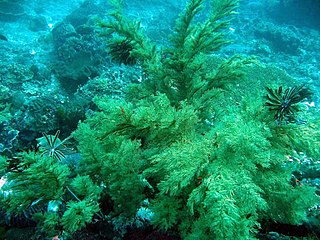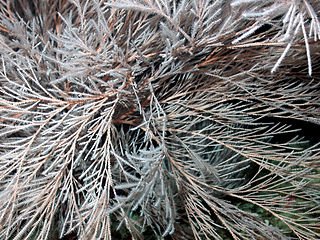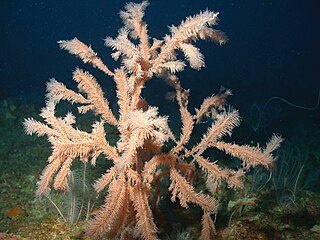
Antipatharians, also known as black corals or thorn corals, are an order of soft deep-water corals. These corals can be recognized by their jet-black or dark brown chitin skeletons, which are surrounded by their colored polyps. Antipatharians are a cosmopolitan order, existing in nearly every oceanic location and depth, with the sole exception of brackish waters. However, they are most frequently found on continental slopes under 50 m (164 ft) deep. A black coral reproduces both sexually and asexually throughout its lifetime. Many black corals provide housing, shelter, food, and protection for other animals.

Rhizostomeae is an order of jellyfish. Species of this order have neither tentacles nor other structures at the bell's edges. Instead, they have eight highly branched oral arms, along which there are suctorial minimouth orifices. These oral arms become fused as they approach the central part of the jellyfish. The mouth of the animal is also subdivided into minute pores that are linked to coelenteron.

Crown jellyfishes are the six families of true jellyfish that belong to the order Coronatae. They are distinguished from other jellyfish by the presence of a deep groove running around the umbrella, giving them the crown shape from which they take their name. Many of the species in the order inhabit deep sea environments.

Werner syndrome ATP-dependent helicase, also known as DNA helicase, RecQ-like type 3, is an enzyme that in humans is encoded by the WRN gene. WRN is a member of the RecQ Helicase family. Helicase enzymes generally unwind and separate double-stranded DNA. These activities are necessary before DNA can be copied in preparation for cell division. Helicase enzymes are also critical for making a blueprint of a gene for protein production, a process called transcription. Further evidence suggests that Werner protein plays a critical role in repairing DNA. Overall, this protein helps maintain the structure and integrity of a person's DNA.

Mastigiidae is a family of true jellyfish. The family is native to the Indo-Pacific, but a species of Mastigias has been introduced to the West Atlantic, and Phyllorhiza punctata has been introduced to the West Atlantic and Mediterranean Sea.

Hexacorallia is a class of Anthozoa comprising approximately 4,300 species of aquatic organisms formed of polyps, generally with 6-fold symmetry. It includes all of the stony corals, most of which are colonial and reef-forming, as well as all sea anemones, and zoanthids, arranged within five extant orders. The hexacorallia are distinguished from another class of Anthozoa, Octocorallia, in having six or fewer axes of symmetry in their body structure; the tentacles are simple and unbranched and normally number more than eight. These organisms are formed of individual soft polyps which in some species live in colonies and can secrete a calcite skeleton. As with all Cnidarians, these organisms have a complex life cycle including a motile planktonic phase and a later characteristic sessile phase. Hexacorallia also include the significant extinct order of rugose corals.

Octocorallia is a class of Anthozoa comprising over 3,000 species of marine organisms formed of colonial polyps with 8-fold symmetry. It includes the blue coral, soft corals, sea pens, and gorgonians within three orders: Alcyonacea, Helioporacea, and Pennatulacea. These organisms have an internal skeleton secreted by mesoglea and polyps with eight tentacles and eight mesentaries. As with all Cnidarians these organisms have a complex life cycle including a motile phase when they are considered plankton and later characteristic sessile phase.

Antipathidae is a family of corals in the order Antipatharia, commonly known as black corals. They are generally considered a deep-water taxon; however, some of the most diverse communities are known from tropical shallow waters.
Allopathes is a genus of corals in the family Antipathidae. It is characterized by several long stems protruding from a short, thick base with spines arranged vertically around the stem. Its polyps are arranged in a single row that run the length of the coral. This genus was initially a subgenus of Cirrhipathes and Stichopathes, although it also displayed similarities to Antipathes verticillata. However, the presence of branched growth forms excludes it from Stichopathes or Cirrhipathes and the unique morphology of its spines meant that it could not be included in Allopathes. Because they seemed to have a combination of characteristics of different genera, the two species in question, Allopathes desbonni and Allopathes robillardi were given their own genus.

Antipathes is a genus of coral in the order Antipatharia, composed of black coral. Distinct features vary greatly within this genus: it contains symmetrically aligned as well as irregularly shaped corals, a range of different colors, and colonies that can be either sparsely branched or closely packed. polyps for these corals have six tentacles that are each lined with stinging cells. Unlike their reef-building cousins, these coral lack photosynthesizing algae and are not restricted to the lighter surface regions. They prefer to live in deeper waters near currents so they can catch and eat passing zooplankton.

Aphanipathes is a diverse genus of black corals in the family Aphanipathidae, typified by large polypar spines. However, there are some disagreement in the correct taxonomic classification of this genus. The Global Biodiversity Information Facility (GBIF) classifies Aphanipathes as being a genus of the family Aphanipathidae while the Integrated Taxonomic Information System (ITIS) classifies it as a genus of the family Antipathidae.

Antipathes dichotoma is a species of colonial coral in the order Antipatharia, the black corals, so named because their calcareous skeletons are black. It was first described by the German zoologist and botanist Peter Simon Pallas in 1766, from a single specimen he received from near Marseilles in the Mediterranean Sea.

Leiopathes is a genus of hexacorallians belonging to the anthozoan clade Antipatharia. It is the only genus in the Leiopathidae family. The genus name means "smooth disease".

Antipathes dendrochristos, commonly known as Christmas tree coral, is a species of colonial coral in the order Antipatharia, the black corals, so named because their calcareous skeletons are black.
Myriopathidae is a family of cnidarians belonging to the order Antipatharia.
Stylopathidae is a family of corals belonging to the order Antipatharia.

Tanacetipathes is a genus of corals belonging to the family Myriopathidae.
Bathypathes is a genus of black coral in the family Schizopathidae.
Alternatipathes is a genus of corals belonging to the family Schizopathidae.
Alternipathes bipinnata is a species of coral belonging to the family Schizopathidae. It has been found off the Pacific coast of Mexico.












